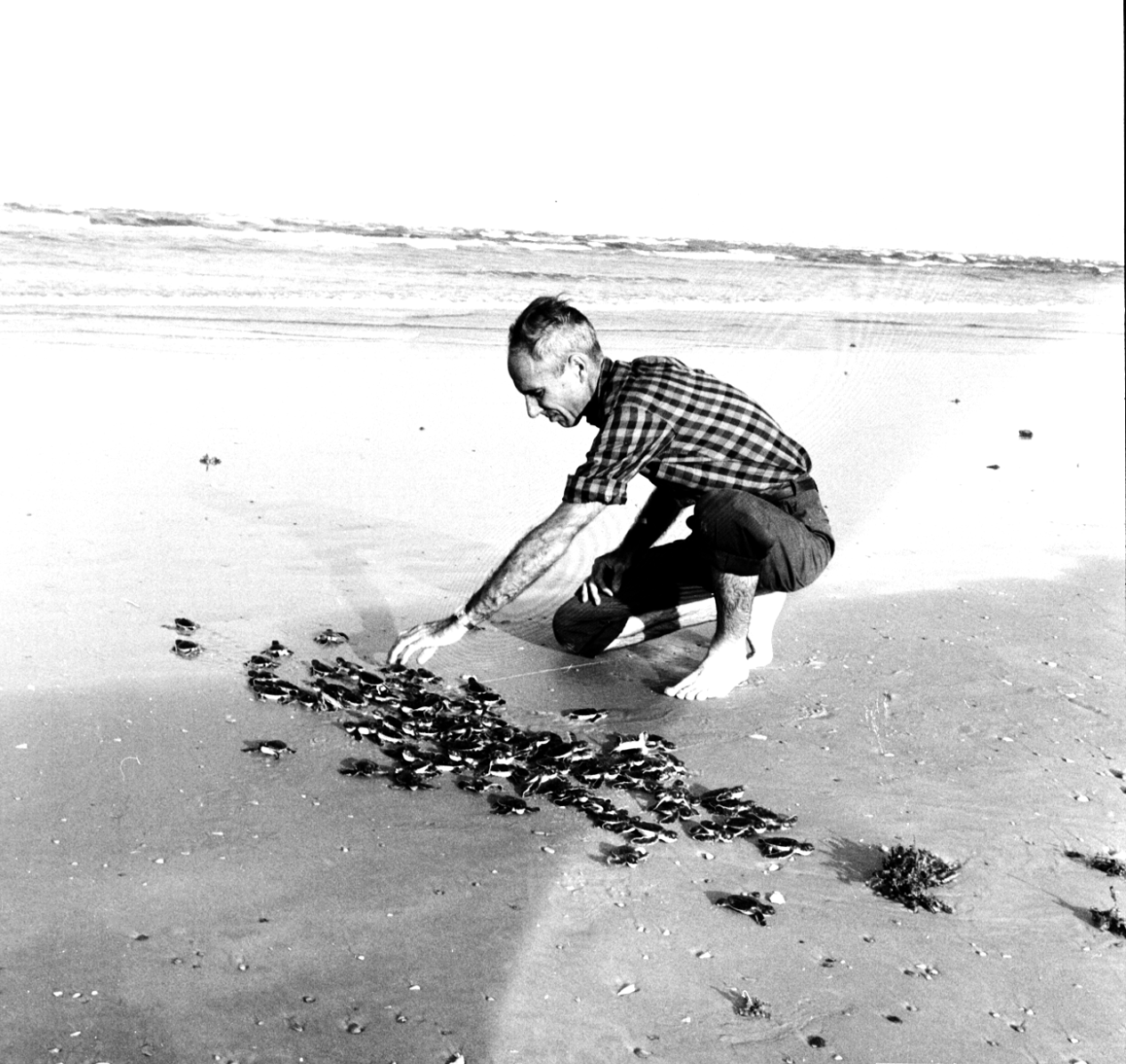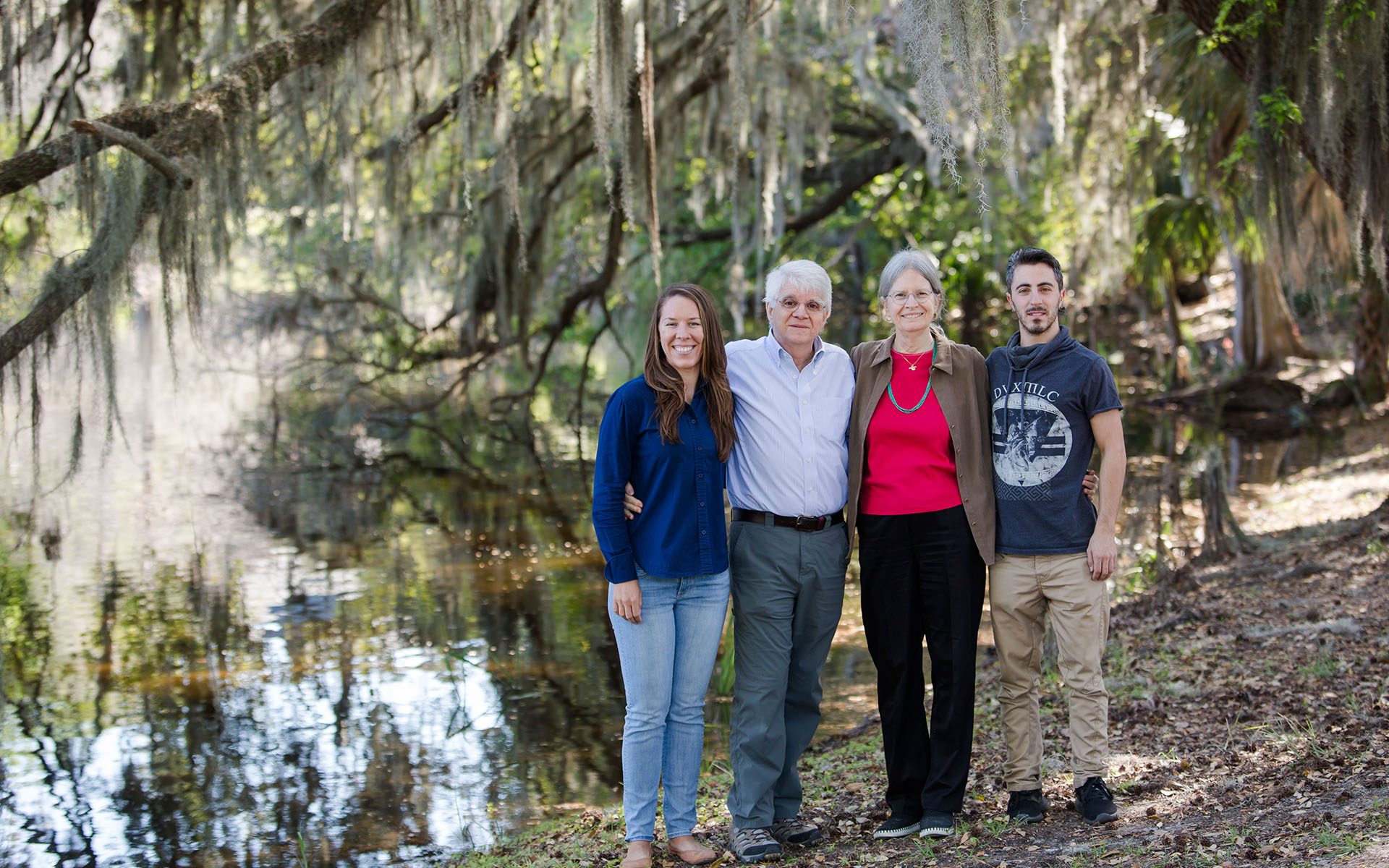Archie Carr, a larger-than-life man who could summon a snapping turtle named Jasper at will, paved the way for the conservation of sea turtles around the world. Karen Bjorndal, his former graduate student, and Alan Bolten today direct the Archie Carr Center for Sea Turtle Research at UF, carrying on his life’s work and legacy. In many ways, the University of Florida saved the sea turtles.
When UF Distinguished Professor of Biology Karen Bjorndal PHD’79 was an undergraduate student in the 1970s, she set her research sights on iguanas. Set on going to the Galápagos, she embarked on a six-month research trip to study the social behavior of land iguanas, but soon found herself enthralled by a different reptile. “I would sit on the coastline and stare out for hours at the sea as green turtles would pass by, coming to the surface to breathe,” she recalls. “I was really intrigued by these two different worlds converging.” She left the land iguanas behind and went to UF determined to study with the man who knew more about green turtles than anyone in the world: Archie Carr PHD’37. In fact, Carr knew more about all realm-crossing sea turtles at the time.
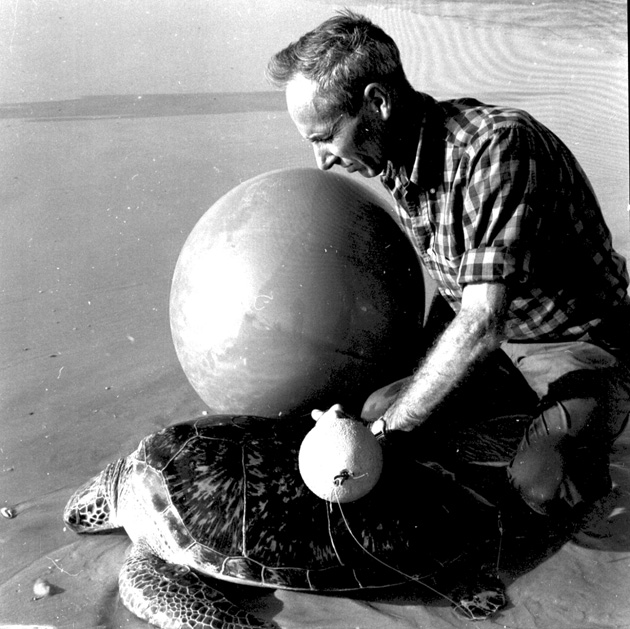
Carr, who was the first person to earn a PhD in zoology from UF, had also fallen under the sea turtle spell, publishing his first paper on them in 1942. “He had worked primarily with freshwater species,” says Bjorndal. “Then, he published Handbook of Turtles: The Turtles of the United States, Canada, and Baja California [1952], and he started reading about sea turtles to complete those sections. He became entranced, particularly with their ability to navigate. He heard stories from Nicaraguan fishermen who had caught, marked and sent green turtles to Florida markets, and then six months later, caught those same turtles back in Nicaragua after they had been released from holding pens by storms.”
Yet the scientific literature had significant gaps that Carr took it upon himself to fill. “When you go back to early literature, it’s hard to remember that almost nothing was known and no one was studying them,” says Bjorndal. Carr’s legacy is multifold, and a large component of it is the research center established in his name at UF located in Carr Hall. Bjorndal now directs the Archie Carr Center for Sea Turtle Research (ACCSTR), which trains biology graduate students to become marine biologists with a conservation focus, as Carr had. “He was a fantastic scientist who wrote beautifully for the general public, and that is what rallied the troops, when he first learned in the late ’40s and ’50s that turtles were undergoing incredible decline,” says Bjorndal.
Archie Carr was born in Mobile, Ala., a delta-based city with a Gulf-pounded coast, a land of reptile-filled swamps, including the near-mythical alligator snapping turtle. He lived and studied in Alachua County most of his adult life, as a biology undergraduate student turned herpetology graduate student turned UF graduate research professor. Appropriately, his Micanopy home overlooked a pond that was home to a gator, who once chased him up a tree in defense of her nest, as well as an alligator snapping turtle who responded to the name Carr gave it, Jasper.
“Archie had so many great stories like that,” says Bjorndal. “With Archie, anything became an adventure.” That Carr was larger-than-life in so many ways is captured in archival photographs showing Carr affectionately holding turtles, admiring hatchlings’ march to the sea, and working with students on various conservation tasks, including attaching weather balloons to the turtles to track their journeys. Contemporary researchers’ comments on Carr use descriptors such as “inspiring,” “passionate,” and “generous” that appear again and again. “Archie did so much that no one could have replaced him,” says Bjorndal. After his passing in 1987, she picked up the Center’s research and graduate student mentoring, while another of Carr’s students, Peter Pritchard ’69, took on the mantle of Carr’s famed writing for a popular audience.
Alongside Bjorndal is her husband, Alan Bolten PhD’86, whom she met while both were graduate students at UF and brought into the sea turtle spirit. He had been studying the social behavior of insects, especially the Africanized killer bee for his dissertation. “I introduced him to more peaceful creatures, and ever since then we’ve worked together,” she says.
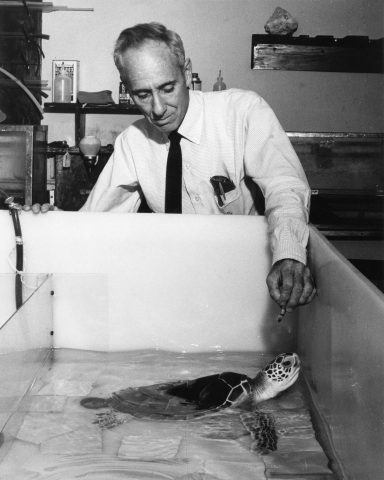
“The green turtle has always been Archie’s main focus, and mine as well.” — Karen Bjorndal
Conservationists, marine biologists, and herpetologists around the world esteem Carr for his inception and continued invigoration of sea turtle research and conservation, including significant insights into nesting behavior of the mysterious Kemp’s Ridley. Sea turtles’ long lifespans, wide ranges, and scarce appearances on land make them challenging study subjects; meanwhile, they are so intricately connected with disparate ecosystems that they are themselves barometers of the oceans’ health — and susceptible to its many ailments, from overfishing to coastal development to climate change.
On all of these counts, the Archie Carr Center for Sea Turtle Research has made great strides. Its researchers revealed a solution for the well-documented problem of hatchlings confusing artificial lights with the moon’s reflection upon the sea: low-pressure sodium lights that the hatchlings cannot perceive are now used in buildings and streets along the Florida coastline. They discovered that warming oceans mean slower growth rates and quintupled the estimate for when green turtles reach sexual maturity; life cycles must be taken into account for nest-protection programs. They pushed for a ban in the Bahamas on harvesting sea turtles for food, a practice that decimated the local turtle population. The ban finally took effect in 2009, a milestone that Bolten and Bjorndal found very rewarding. “We see so many green turtles now!” says Bjorndal.
Such accomplishments attest to the strength of scholarship and breadth of research conducted by ACCSTR. Their scope extends from molecular population genetics to grand overviews of turtle migration patterns. “One really nice part about being at UF is the diversity of disciplines that are here,” says Bolten. “We really take advantage of that in terms of collaborating with colleagues in the medical school or the vet school, coastal engineering, wildlife, the law school. Our research is quite diverse, and we go through periods of different focuses, depending on interests of graduate students and what’s important with respect to answering certain conservation questions.”
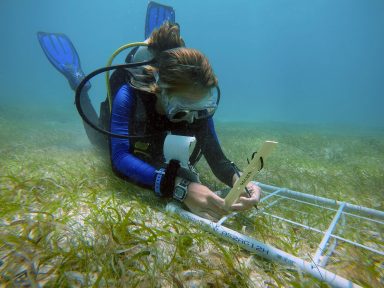
ACCSTR assistant and UF alumna Ashley Meade ’17 measures seagrass blade parameters at Buck Island Reef National Monument in the Virgin Islands. Alexandra Gulick
Recently, those questions have revolved around seagrass habitats and sea turtles’ interaction with them. The green turtle is unusual in that it is primarily herbivorous and will happily eat seagrasses and algae. “The green turtle has always been Archie’s main focus, and mine as well,” says Bjorndal, whose dissertation described the fermentation process, akin to a horse’s digestive system, that the green turtle uses to digest seagrass and algae. Not unlike horses, green turtles graze on pastures — of seagrass that sweep the ocean floor. Currently, several graduate students’ projects tackle the ecology and behavioral patterns of the green turtles who “mow” the grass.
Following the Bahamian ban and years of successful conservation efforts, the green turtle population consequentially boomed — and many seagrass habitats that had appeared pristine were soon trimmed short. The question arose, What had been the natural state of the ecosystem before over-hunting of turtles? “Seagrass pastures and green turtles co-evolved, so when humans reduced their numbers to 3–5 percent of what they had been, the meadows expanded, but there is now some alarm from those who think they’re destroying the pastures,” says Bjorndal. “Our graduate students are examining whether it’s an illusion that the ecosystems are being destroyed.”
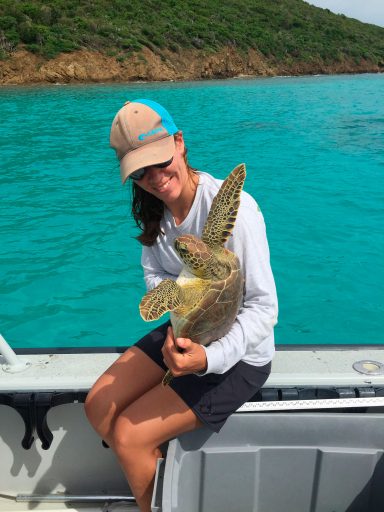
Graduate student Alexandra Gulick is evaluating the productivity of turtle-grazed seagrass “meadows” and how seagrass ecology may influence green turtle grazing behavior. “I feel incredibly fortunate to be learning from such a collaborative and inspiring group of scientists,” she says. “The ACCSTR plays an invaluable role in providing the research and outreach necessary to bridge the gap between the public, policy, and the goals of sea turtle conservation.”
Carr’s other favorite turtle was the loggerhead, and he was particularly intrigued by what he called “the lost year.” Loggerhead hatchlings depart beaches along the Atlantic coast and head out for the sea, but research had been unable to determine where they went and what they did afterward. While Bjorndal picked up Carr’s green turtle track, Bolten focused on this mystery. His research has shown that the lost year is actually more of a lost decade; during their first 10 years of life, loggerheads are entirely oceanic. During this life stage, they are vulnerable to longline fishing, which standardly used a J-shaped hook that fatally ensnared turtles. Bolten sought a solution for this problem and found potential in a circle-shaped hook. “I would go to meetings and use a nylon stocking to demonstrate that circle hooks can be removed,” he says. “But then we got a high shark bycatch rate with this type of hook. We can’t prevent harm to turtles at the expense of other animals.”

Carr was most interested in the green turtle and the loggerhead, shown here. It is classified as a vulnerable species by the International Union for the Conservation of Nature.
By tracking life cycle activities of turtles, ACCSTR can produce a better solution: scheduling commercial fishing activity and restricting equipment according to when and where vulnerable species are in a particular geographic zone. “Of course, being international waters, this approach requires a certain political will,” says Bolten.
If Carr’s legacy is any indication, efforts for ocean health and sea turtle conservation are increasing. “His writings were what spurred interests around the world,” says Bjorndal. Gulick adds, “As an aspiring scientist, I’m excited to contribute to a legacy of work that has been successful in garnering support from so many, all of whom want to see sea turtles fulfill their ecological roles once again.”
Bjorndal recalls something French marine biologist Jacques Fretey once said to her about sea turtle scientists, “We are all Archie’s children.” Both his seminal work and his big personality enthralled and inspired new generations of marine biologists and herpetologists. “That’s a feeling that persists so many years after his passing amongst sea turtle biologists around the world,” says Bjorndal. “We still honor and love him. That’s why his birthday [June 16] is International Sea Turtle Day.”
